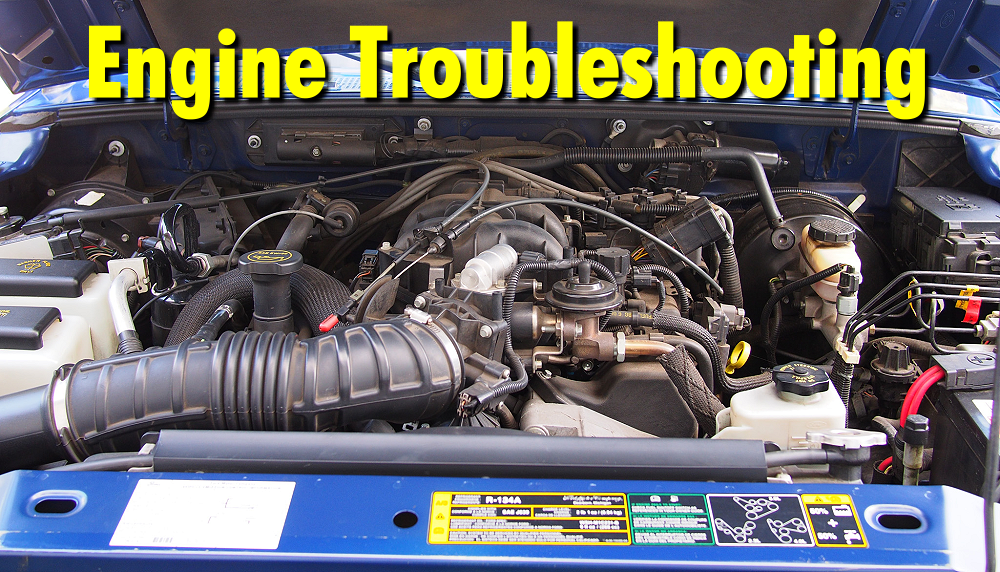Did you check the codes?
Is your check engine light on? If so, use a scan tool and see if any codes are present.
Testing EEC-IV Equipped Vehicles
OBD-II Trouble Codes 1996-Up Ranger (Example: P0100)
Your engine is stalling / dying or sputtering when hot but runs when it cools off:
This can be caused by a faulty TFI and the biggest culprits are heat. Another culprit can be a wire grounding out. Problematic TFI’s can give off codes 14 (PIP) and 18 (SPOUT).
Here are some links you may find helpful:
Ford EEC-IV/TFI-IV Electronic Engine Control Troubleshooting
TFI Worksheet (Strongly recommend you print this worksheet)
Engine will not rotate when attempting to start:
1. Battery terminal connections loose or corroded. Check the cable terminals at the battery. Tighten the cable or remove corrosion as necessary.
2. Battery discharged or faulty. If the cable connections are clean and tight on the battery posts, turn the key to the On position and switch on the headlights and/or windshield wipers. If they fail to function, the battery is discharged.
3. Automatic transmission not completely engaged in Park or Neutral or clutch pedal not completely depressed.
4. Broken, loose or disconnected wiring in the starting circuit. Inspect all wiring and connectors at the battery, starter solenoid and ignition switch.
5. Starter motor pinion jammed in flywheel ring gear. If manual transmission, place transmission in gear and rock the vehicle to manually turn the engine. Remove starter and inspect pinion and flywheel at earliest convenience
6. Starter solenoid faulty
7. Starter relay faulty
8. Starter motor faulty
9. Ignition switch faulty
Engine dies after jump starting and removing the jumper cables:
The alternator isn’t putting out a charge. If the battery was bad, the engine would still run off the alternator, but would not restart since it’s not charging the battery.
Engine rotates, but will not start:
1. Fuel tank empty.
2. Fault in the fuel injection system
3. Battery discharged (engine rotates slowly). Check the operation of electrical components
4. Battery terminal connections loose or corroded
5. Fuel pump faulty
6. Excessive moisture on, or damage to, ignition components
7. Worn, faulty or incorrectly gapped spark plugs
8. Broken, loose or disconnected wiring in the starting circuit
9. Broken, loose or disconnected wires at the ignition coil pack or faulty coil ‘pack
10. Broken, loose or damaged timing belt
Starter motor operates without rotating engine:
1. Starter pinion sticking. Remove the starter and inspect.
2. Starter pinion or flywheel teeth worn or broken. Remove the flywheel/driveplate access cover and inspect.
Engine hard to start when cold:
1. Battery discharged or low
2. Fault in the fuel or electrical systems
Engine hard to start when hot:
1. Air filter clogged
2. Fault in the fuel or electrical systems
3. Fuel not reaching the injectors
Starter noisy or rough in engagement:
1. Pinion or flywheel gear teeth worn or broken. Remove the cover at the rear of the engine (if equipped) and inspect.
2. Starter motor mounting bolts loose or missing.
Engine starts, but stops immediately:
1. Loose or faulty electrical connections at distributor, coil or alternator.
2. Fault in the fuel or electrical systems
3. Vacuum leak at the gasket surfaces of the intake manifold or throttle body. Make sure all mounting bolts/nuts are tightened securely and all vacuum hoses connected to the manifold are positioned properly and in good condition.
Engine lopes at idle, or idles erratically:
1. Vacuum leakage. Check the mounting bolts/nuts at the throttle body and intake manifold for tightness. Make sure all vacuum hoses are connected and in good condition. Use a stethoscope or a length of fuel hose held against your ear to listen for vacuum leaks while the engine is running. A hissing sound will be heard. A soapy water solution will also detect leaks.
2. Fault in the fuel or electrical systems
3. Plugged PCV valve
4. Air filter clogged
5. Fuel pump not delivering sufficient fuel to the fuel injectors
6. Leaking head gasket. Perform a compression check
7. Camshaft lobes worn
Engine misses at idle speed:
1. Spark plugs worn, fouled or not gapped properly
2. Fault in the fuel or electrical systems
3. Faulty spark plug wires
4. Vacuum leaks at intake or hose connections.
5. Uneven or low cylinder compression. Check compression

